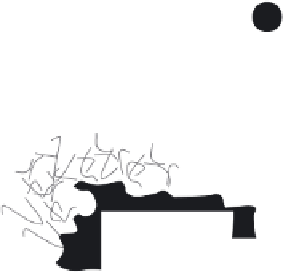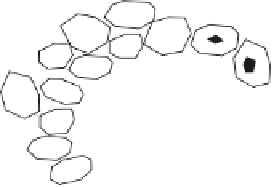Biomedical Engineering Reference
In-Depth Information
Reduced access of
analyte molecule
to biosensor
Fibrous and
cellular
encapsulation
Sensor
fouling
Enzyme
degradation
Enzyme
Electrode
11.8
Some of the problems associated with long-term biosensor
implantation. Interaction between the sensor and blood leads to
degradation of sensor components, protein adsorption, platelet
adhesion and aggregation, thrombus formation, and fi brous
encapsulation of the sensor. This can cause problems associated with
sensor sensitivity, stability, reliability and safety.
11.4.2 Long-term implantable biosensors
The long-term implantation of sensors for the continuous
in vivo
monitor-
ing of various physical and chemical parameters has been widely researched,
but not yet fully realised, owing to various technical challenges and the
issues of biocompatibility associated with implanted sensors. Much has
been written on the subject of the biocompatibility of implantable chemical
and biological sensors, which is considered the major barrier to their routine
clinical utilisation.
43-45
The response of the body to the presence of foreign
materials is to trigger a set of biological reactions that result in deterioration
of sensor function through degradation of enzyme and electrode, and
impairment of analyte access by protein fouling and fi brous encapsulation,
46
as illustrated in Fig. 11.8.
The sensing interface is changed
in vivo
in such a way as to be totally
different from the one that was carefully designed outside the body.
44
As a
result the sensor is less sensitive to the analyte being measured and gives
erroneous analytical data. In addition to the physical barrier produced to
analyte diffusion, the metabolic activity in the area around the sensor is
changed by these physiological processes, which can also affect the accuracy
of parameter measurement.
43
Immediately a sensor is implanted proteins
are adsorbed to its surface. If the sensor is an intravascular device these
proteins are capable of triggering the coagulation cascade, i.e. fi brinogen,
von Willebrand's factor and Factor XII. Platelets then adhere to the implant,








Search WWH ::

Custom Search